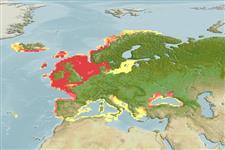Environment: milieu / Zona climática / intervalo de profundidade / distribution range
Ecologia
marinhas; estuarina bentopelágico; oceanódromo (Ref. 51243); intervalo de profundidade 10 - 200 m (Ref. 1371), usually 30 - 100 m (Ref. 1371). Temperate; 72°N - 35°N, 27°W - 42°E
Northeast Atlantic: southeastern Barents Sea and Iceland to Portugal, also in the Black Sea, Aegean Sea, Adriatic Sea and adjacent areas. Rare in the northwestern Mediterranean.
Comprimento de primeira maturação / Tamanho / Peso / Idade
Maturidade: Lm 28.2, range 28 - 30 cm
Max length : 91.5 cm TL macho/indeterminado; (Ref. 106276); common length : 23.5 cm TL macho/indeterminado; (Ref. 1371); peso máx. publicado: 3.1 kg (Ref. 40637); idade máx. registrada: 20 anos (Ref. 35388)
Espinhos dorsais (total) : 0; Raios dorsais (total) : 30 - 40; Raios anais : 30 - 35. Body elongate; head small. Chin barbel small or absent. Lateral-line canals on head with pores. Color is variable; yellowish-brown, dark blue or green, sides yellowish grey, white and silvery on belly; often with a small dark blotch at the upper base of the pectoral fin.
Body shape (shape guide): fusiform / normal; Cross section: circular.
More commonly found from 30 to 100 m, mainly on mud and gravel bottoms, but also on sand and rock. Feed on shrimps, crabs, mollusks, small fish, polychaetes and cephalopods. Migrate to the open sea only after the first year of life. Eggs are pelagic. Larvae and juveniles are associated with jellyfish. Upon maturity, small chin barbel characteristic of juveniles disappear (Ref. 53061). Spawn in batches (Ref. 51846). Utilized fresh, dried or salted, smoked and frozen; eaten steamed, broiled and baked (Ref. 9988).
Oviparous, sexes are separate (Ref. 205).
Cohen, D.M., T. Inada, T. Iwamoto and N. Scialabba, 1990. FAO species catalogue. Vol. 10. Gadiform fishes of the world (Order Gadiformes). An annotated and illustrated catalogue of cods, hakes, grenadiers and other gadiform fishes known to date. FAO Fish. Synop. 125(10). Rome: FAO. 442 p. (Ref. 1371)
Status na Lista Vermelha da UICN (Ref. 130435: Version 2025-1)
Ameaça para os humanos
Harmless
Uso pelos humanos
Pescarias: altamente comercial; peixe esportivo: sim; Aquário: Aquários públicos
Ferramentas
Relatórios especiais
Baixar XML
Fontes da internet
Estimates based on models
Preferred temperature (Ref.
123201): 7 - 11.9, mean 9.2 °C (based on 409 cells).
Índice de diversidade filogenética (Ref.
82804): PD
50 = 1.0000 [Uniqueness, from 0.5 = low to 2.0 = high].
Bayesian length-weight: a=0.00617 (0.00547 - 0.00695), b=3.06 (3.02 - 3.10), in cm total length, based on LWR estimates for this species (Ref.
93245).
Nível Trófico (Ref.
69278): 4.4 ±0.2 se; based on diet studies.
Generation time: 5.3 (4.4 - 6.8) years. Estimated as median ln(3)/K based on 23
growth studies.
Resiliência (Ref.
120179): médio(a), tempo mínimo de duplicação da população 1,4 - 4,4 anos (rm=1.1-1.6(?); K=0.07-0.74; tm=1-4; tmax=20; Fec>100,000).
Prior r = 0.49, 95% CL = 0.33 - 0.74, Based on 20 full stock assessments.
Fishing Vulnerability (Ref.
59153): High to very high vulnerability (67 of 100).
🛈
Climate Vulnerability (Ref.
125649): Moderate to high vulnerability (47 of 100).
🛈
Nutrients (Ref.
124155): Calcium = 18 [9, 36] mg/100g; Iron = 0.2 [0.1, 0.6] mg/100g; Protein = 18 [16, 20] %; Omega3 = 1 [0, 2] g/100g; Selenium = 17.8 [8.2, 36.9] μg/100g; VitaminA = 11.9 [3.0, 48.0] μg/100g; Zinc = 0.242 [0.129, 0.709] mg/100g (wet weight); based on
nutrient studies.
